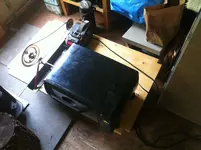Axel
New member
- Jul 15, 2015
- 32
- 0
What is the optimal commercial roaster?
maybe something that can handle 25-50lbs ..or whatever is an optimal batch size...
By optimal I mean:
consistent high quality roast relatively not effected by external climate while retaining great fine tuning ability.
+size of drum(diameter, length, and wall thickness)
+size of propane burners(BTU's, length, etc..)
+Drum rotation speed(motor/gear specs)
+air circulation(this is probably a loaded question)
+any other relevant specs to build a well balanced roaster...
Thanks!
maybe something that can handle 25-50lbs ..or whatever is an optimal batch size...
By optimal I mean:
consistent high quality roast relatively not effected by external climate while retaining great fine tuning ability.
+size of drum(diameter, length, and wall thickness)
+size of propane burners(BTU's, length, etc..)
+Drum rotation speed(motor/gear specs)
+air circulation(this is probably a loaded question)
+any other relevant specs to build a well balanced roaster...
Thanks!
